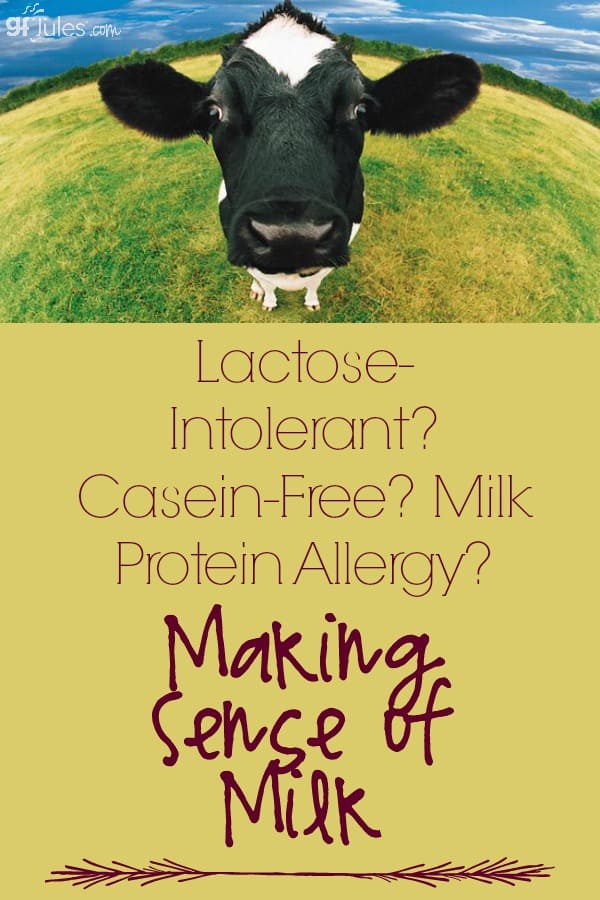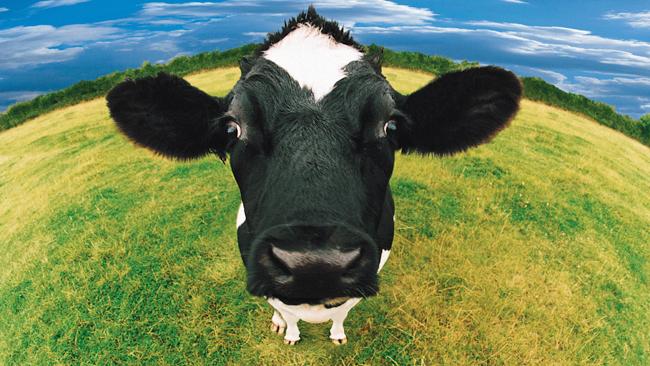Going gluten free is a process. For some, the health benefits are marked and immediate once they stop eating gluten; for others though, it takes time to feel truly better once they have eliminated gluten from their diets altogether. But sometimes removing gluten is not enough.
If you are living gluten free but still don’t feel complete relief from all your gastrointestinal symptoms, chances are you will feel even better when you cut dairy from your diet. Lactose intolerance is often the culprit, but there are other reasons why dairy can be difficult for some to digest.
>>Did you know ALL of my recipes are already gluten-free AND dairy-free? Lucky you!
Lactose Intolerance
 For me and a majority of others with celiac disease (“CD”), eliminating dairy from our diets is required, as our bodies no longer produce lactase, the enzyme necessary to break down the milk sugar called lactose. When we eat dairy containing lactose, gastrointestinal discomfort of some kind is a sure result. Many of us with celiac disease developed secondary lactose intolerance/lactase deficiency from injury to our small intestines because of years of undiagnosed CD. Approximately 50% of those with gluten sensitivity also are sensitive to dairy.
For me and a majority of others with celiac disease (“CD”), eliminating dairy from our diets is required, as our bodies no longer produce lactase, the enzyme necessary to break down the milk sugar called lactose. When we eat dairy containing lactose, gastrointestinal discomfort of some kind is a sure result. Many of us with celiac disease developed secondary lactose intolerance/lactase deficiency from injury to our small intestines because of years of undiagnosed CD. Approximately 50% of those with gluten sensitivity also are sensitive to dairy.
Lactose intolerance (primary or secondary) is quite common in the general population as well, though — in fact, most adults are lactase deficient to some degree. An estimated 30-50 million American adults are lactose intolerant, and certain ethnic groups suffer in far higher numbers, including Asians and American Indians who manifest lactose intolerance in a shocking proportion: 80-100 percent of their populations.
 Lactose is naturally present in all milk by-products (derived from all mammals like goats, sheep, cows and humans), including butter, cream, cheese, cottage cheese, yogurt and ice cream; many other foods and medications contain lactose though, so diligence in reading labels is essential for those avoiding lactose.
Lactose is naturally present in all milk by-products (derived from all mammals like goats, sheep, cows and humans), including butter, cream, cheese, cottage cheese, yogurt and ice cream; many other foods and medications contain lactose though, so diligence in reading labels is essential for those avoiding lactose.
Hard cheeses and yogurts actually contain less lactose, and lactose-free (lactase added) milks are more and more common. Many new lactose-free cheese products have been introduced as well, opening up more options for those avoiding lactose.
Casein & Whey
The sugar in milk products is not the problem for everyone though. Some people experience discomfort or a true allergy to the proteins in milk — primarily, casein and whey. (This is a similar condition to those with allergies to soy, as they are nearly always just allergic to the protein in soy, not other by-products like soy lecithin).

Casein is the curd that forms when milk sours, and whey is the watery portion that is left. Some people are allergic to either whey or casein, but others may be allergic to both; often it is difficult to determine exactly which protein is causing the reaction, and it can be tricky to find food products that list those proteins separately on an ingredient label.
Nutritional labels in the U.S. require only that “milk” be identified in the ingredients, not necessarily what part of the milk is used.
In addition to obvious milk products, protein shakes and supplements often contain whey, as it is a quickly absorbed form of protein that some studies have shown helps to build muscle mass and reduce hunger and fat.
Casein is often found in sherbets, chocolate, ice cream, creamed soups and sauces, puddings and other cheeses, and may even be found in processed meats, margarine, artificial flavorings and ghee. Look for foods labeled Kosher pareve, as these will be casein-free.
Milk Protein Allergy

Thus, for those with milk protein allergy or otherwise avoiding one milk protein or another, avoiding milk products altogether is the only safe solution.
Note: if you are still experiencing gastrointestinal symptoms, even after removing gluten and dairy from your diet, you may want to experiment with eliminating other cross-reactive foods (there are 18 cross-reactive, non-gluten foods that may exacerbate the immune response for gluten sensitive patients). Here is a good summary of these foods and the theory of cross-reactivity from Alisa at Go Dairy Free.
For those avoiding dairy altogether for whatever reason, there are fortunately more and more food solutions. I detail these dairy-free substitutions in my book, Free for All Cooking: 150 Easy Gluten-Free, Allergy-Friendly Foods the Whole Family Can Enjoy.
And here are some great baking tips for making your recipes dairy-free!
 Everything from buttermilk to cream to evaporated milk and ice cream — and every dairy product in between — can be successfully substituted for in your baking. Consult with your doctor to be sure your nutritional needs are being met, and embrace the wonderful dairy-free products and recipes that are available to all of us now.
Everything from buttermilk to cream to evaporated milk and ice cream — and every dairy product in between — can be successfully substituted for in your baking. Consult with your doctor to be sure your nutritional needs are being met, and embrace the wonderful dairy-free products and recipes that are available to all of us now.
*For updated new product information from Natural Products Expo West, listen to the free podcast of The Gluten Free Voice Radio Show.

























I believe your assessment on milk allergy to be deficient insofar as it does not differentiate between raw milk and commercially produced milk, which is, 90% of the time, “ultra-pasturized.” Raw milk carries 8 critical enzymes that actually aid in it’s digestion. All of them are killed by pasteurization. Additionally, most modern cows are bred for high production and carry a corrupted casein molecule that is very difficult for many people to absorb. Heritage dairy breeds do not carry this corrupted casein in the DNA strand and MANY people who cannot tolerate commercial dairy and are diagnosed lactose intolerant or casein intolerant, can accommodate such milk without problems. Further, our modern diet relies heavily on cooked foods, as opposed to raw foods (which carry their own digestive enzymes to the table!), and as we have a limited capacity to create digestive enzymes, we are taxing our bodies more than they are prepared to adjust for. This is a thumbnail sketch and the analysis against reactivity can go much deeper (A1 vs A2 cows, for example), but this is not new news, nor should it be excluded from any analysis of dairy free requirements, as the fats provided by healthy dairy are unsurpassable in their nutritional value. Without them, you cannot really assimilate trace minerals. Without trace minerals, you are dead in the water.
Indeed there is a huge difference in the milk from A1A1 v A1A2 and A2A2 … cows. It’s exciting that many companies are starting to recognize and embrace the more easily digested A2 milks and market it as such. That doesn’t discount the fact that many people can still nonetheless not tolerate cow’s milk of any kind. A2 and raw milks are options to consider, but since there are so many healthy non-dairy options available now as well, there’s no need to rely only on the dairy options anymore. Thanks for your comment and sharing your perspective!
~jules
First off I want to say awesome blog! I had a quick question that I’d like to ask if you do not mind.
I was interested to know how you center yourself and clear your head prior to
writing. I’ve had a tough time clearing my thoughts in getting my
ideas out there. I do enjoy writing but it just seems like the first 10 to 15 minutes tend to be lost
simply just trying to figure out how to begin. Any recommendations or hints?
Kudos!